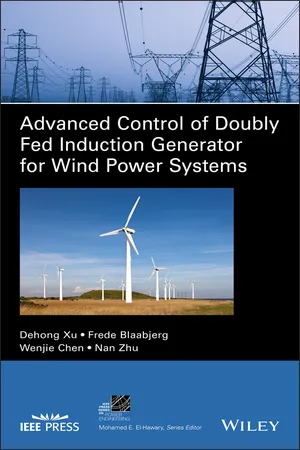
Advanced Control of Doubly Fed Induction Generator for Wind Power Systems
- English
- ePUB (mobile friendly)
- Available on iOS & Android
Advanced Control of Doubly Fed Induction Generator for Wind Power Systems
About This Book
Covers the fundamental concepts and advanced modelling techniques of Doubly Fed Induction Generators accompanied by analyses and simulation results
Filled with illustrations, problems, models, analyses, case studies, selected simulation and experimental results, Advanced Control of Doubly Fed Induction Generator for Wind Power Systems provides the basic concepts for modelling and controlling of Doubly Fed Induction Generator (DFIG) wind power systems and their power converters. It explores both the challenges and concerns of DFIG under a non-ideal grid and introduces the control strategies and effective operations performance options of DFIG under a non-ideal grid.
Other topics of this book include thermal analysis of DFIG wind power converters under grid faults; implications of the DFIG test bench; advanced control of DFIG under harmonic distorted grid voltage, including multiple-loop and resonant control; modeling of DFIG and GSC under unbalanced grid voltage; the LFRT of DFIG, including the recurring faults ride through of DFIG; and more. In addition, this resource:
- Explores the challenges and concerns of Doubly Fed Induction Generators (DFIG) under non-ideal grid
- Discusses basic concepts of DFIG wind power system and vector control schemes of DFIG
- Introduces control strategies under a non-ideal grid
- Includes case studies and simulation and experimental results
Advanced Control of Doubly Fed Induction Generator for Wind Power Systems is an ideal book for graduate students studying renewable energy and power electronics as well as for research and development engineers working with wind power converters.
Frequently asked questions
Information
PART I
INTRODUCTION TO WIND POWER GENERATION
CHAPTER 1
INTRODUCTION
1.1 GLOBAL WIND POWER DEVELOPMENT
1.1.1 Global Environment Challenge and Energy Crisis
1.1.2 Renewable Energy Development

1.1.3 Wind Energy Development
Table of contents
- Cover
- Title Page
- Copyright
- Preface
- Nomenclature
- Part I Introduction to Wind Power Generation
- Part II Modeling and Control of DFIG
- Part III Operation of DFIG Under Distorted Grid Voltage
- Part IV Grid Fault Ride-Through of DFIG
- Part V DFIG Test Bench
- Appendix
- Index
- End User License Agreement